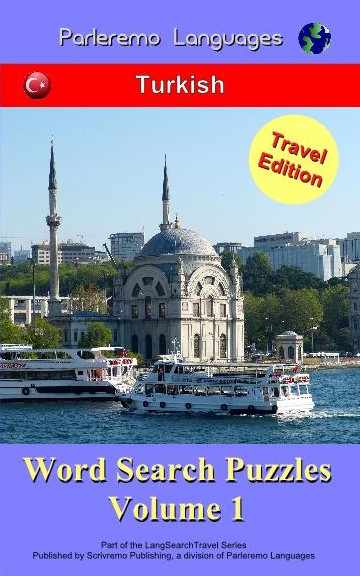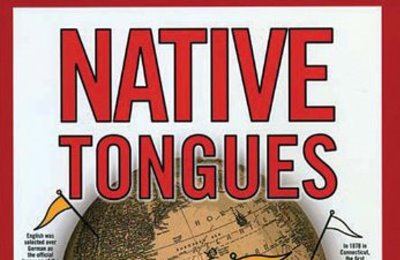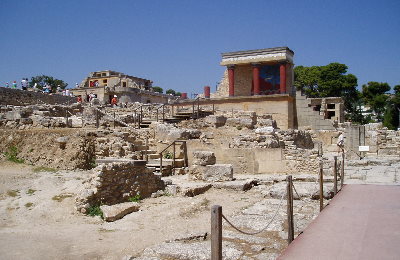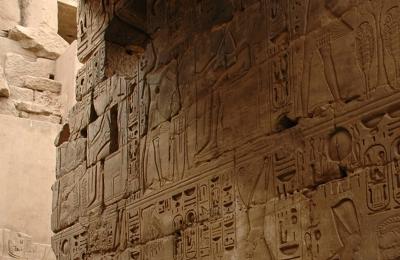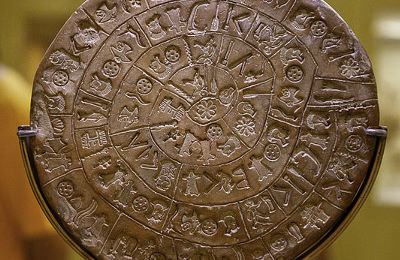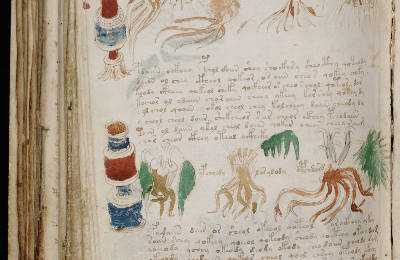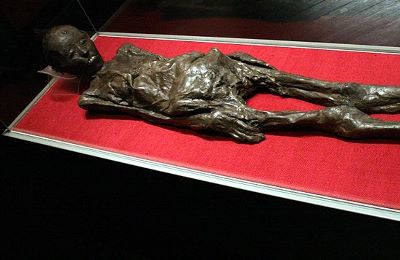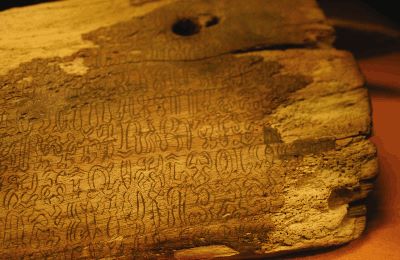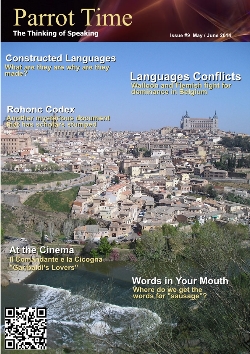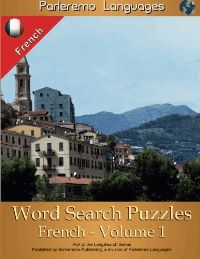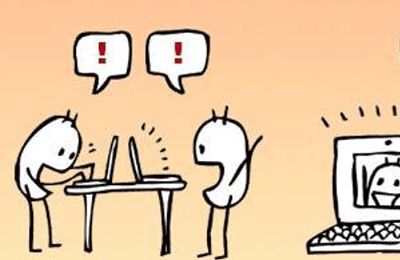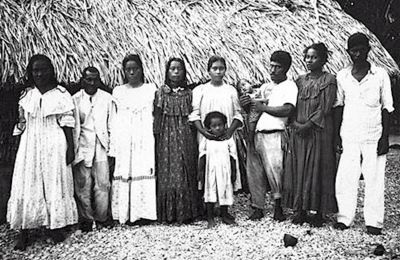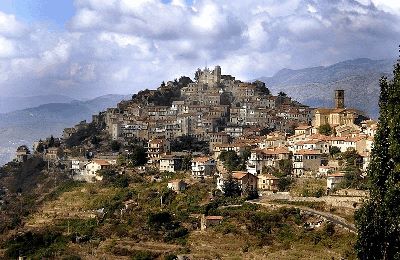Rohonc Codex
Hungarian Enigma

|
The Voynich Manuscript, a booklet full of hand drawn images and undeciphered text, is probably the most famous of strange language documents, but it is not the only one. The Rohonc Codex is another work that has defied translation for centuries, despite the examination by many scholars and the many theories around its meaning. History 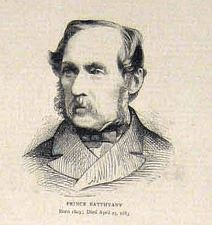 Count Gusztáv Batthyány The codex got its name from the city of Rohonc, in what was Western Hungary, now Rechnitz, Austria. It had been kept there until 1838, at which time it was donated to the Hungarian Academy of Sciences by Gusztáv Batthyány, a Hungarian count, along with the rest of his library. It is unknown how the Count acquired the document. The only possible earlier evidence of it was in a 1743 catalogue of the Batthyány's family library. There is an entry for "Magyar imádságok, volumen I. in 12.", (Hungarian prayers in one volume, size duodecimo). The size matches the codex, but that doesn't prove that this item and the codex are the same.  The Hungarian Academy of Sciences where the Rohonc Codex was first examined. After its entry into the Academy, it was examined by a number of people, first by the Hungarian scholar Ferenc Toldy in 1840 and then by Hungarian linguist and ethnographer Pál Hunfalvy. Neither of them were able to explain the contents. Austrian paleography expert Dr. Mahl was also unable to make sense of the codex after studying it. Between 1884 and 1885, Prague university professors Josef Jirecek and his son, Konstantin Josef Jirecek, studied 32 pages of the codex without finding answers. German researcher, Bernhard Jülg, a professor at Innsbruck University, analysed it in 1885 and Mihály Munkácsy, a Hungarian painter, took the codex with him to Paris for study from 1890 to 1892. The mystery of the codex eluded them as well. The Codex seems to be of medieval origin, with hand-written glyphs and crude black-and-white illustrations. It has its origins in Hungarian history and might possibly be related to Hungarian. The paper upon which it is written contains the watermark of an anchor in a circle with a "star" with six rays (more like an extra limbed starfish than a geometrical star), which is known to have been manufactured in northern Italy around 1530. This is confusing, since the codex itself looks like something from before 1000 AD, and it has been suggested the codex is a copy of an older document which has been completely lost to time, but it also might that it is a fake, especially since there is no evidence of it at all before the 1743 entry. Possible Hoax? Many academics believe the Rohonc Codex to be a fake because of a man named Sámuel Literáti Nemes, a Hungarian antiquarian of the same time period as the donation to the Academy. While there is no known direct link between Nemes and the codex, he was infamous for several forgeries which deceived even the most renowned Hungarian scholars. He would mix these fakes in with legitimate antiques, either for monetary or personal gains. Because of the matching time periods, modern Hungarian historiographers generally consider it one of Nemes forgeries. Translation Attempts 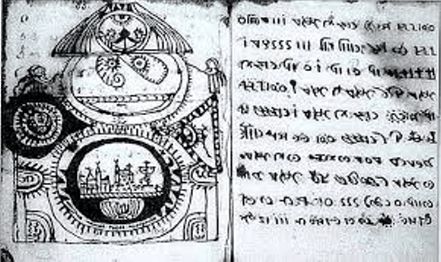 Pages of the codex with an image on the right page. Even with the possibility of it being a fake, scholars and linguists have made several attempts to decode the Rohonc Codex. Physically, the codex is composed of 448 paper pages, each about 12x10 cm in size, with between 9 and 14 rows of symbols or glyphs. There are also 87 drawings that include religious, non-religious, and military scenes. With the inclusion of a mix of religious symbols, it has been suggested it was written in the concept of a situation with Christian, pagan and Muslim religions coexisting. The glyphs seem to read from right to left because of the right justification. It is thought to be related to Hungarian not only because of its discovery location but also because the glyphs bear a resemblance to Old Hungarian script; both are written right to left and they have a similar mix of straight-lined, rune-like characters and rounded characters. The Codex seems to be of medieval origin, with hand-written glyphs and crude black-and-white illustrations. While it contains over two hundred characters, several times more than any known alphabet, it is possible that since most of them are used rarely, the codex might be using a syllabary, in which the rare characters represent specific names or common words. Most alphabets have between twenty to forty characters while syllabaries have eighty to a hundred. Logosyllabic writing systems, like Chinese, have thousands. The first strictly methodical study of the symbols was done by Ottó Gyürk. He examined sequences which were repeated in order to find the direction of writing, claiming the codex reads from right-to-left, top-to-bottom based on the way the repeated parts appeared when broken up between two lines. In the mid-1990s, Miklós Locsmándi did some computer-based research on the text, in which he confirmed the published findings of Gyürk. He also found no evidence of case endings, which are normally part of Hungarian, suggesting the text was probably not in a language closely related to Hungarian. His analysis could not prove the codex a hoax because there were too many regularities in the text for it to be just random. Hungarian-Sumerian 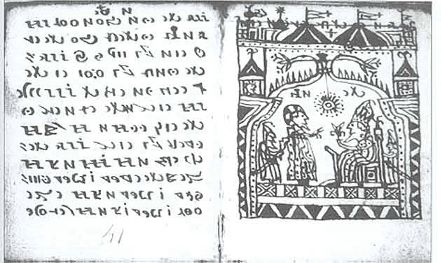 Pages of the codex with an image on the left page. One possible translation attempt was made by Attila Nyíri of Hungary. His solution came after studying only two pages of the codex, and it was to turn the pages upside down. After doing this, he identified what he claimed was a Sumerian ligature (a symbol formed when two letters are combined), then he assigned Latin letters to the rest of the characters based on their resemblance. This was problematic, however, because he would sometimes transliterate the same symbol as a different letter (i.e., translate a character one time as an "a", another time as an "o"). He also sometimes associated a Latin letter to two different symbols. In other words, the associations were more pragmatic in order to force some meaning, rather than systematic. He even rearranged them sometimes to force sense into the text. For these reasons, Nyíri's proposal was immediately denounced by Ottó Gyürk, who noted that by using such a loose deciphering method, anything could have been extrapolated from the codex. Brahmi-Hindi It was suggested by Indian Mahesh Kumar Singh that the codex was actually meant to be written left-to-right, top-to-bottom in an undocumented variant of the Brahmi script. He created a transliterated version of the first 24 pages of the codex into a Hindi text, which he then translated to Hungarian. He alleged it to be an unknown gospel with a narrative of Jesus. With the complete lack of evidence on the Brahmi script he used and method of conversion, his solution was considered a hoax itself. Dacia 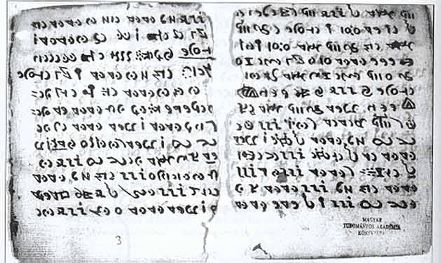 More text of the mysterious writing. Another attempt at decoding the codex was made by Romanian philologist Viorica Enachiuc, who claimed that text was written in the Vulgar Latin dialect of Dacia. She said the direction of writing was right-to-left but from bottom-to-top, and that the text is an 11-12th century history of the Vlachs people and their struggle against the Hungarians and Pechnegs. While Enachiuc offered up a chunk of translation, it was criticized for not logically matching the patterns of the codex. Symbols that would appear in the same context throughout the codex were regularly transliterated with different letters, meaning different meanings were affixed to the same groups, losing the pattern of the original text. Continuing Attempts There are still people attempted to decoded the Rohonc Codex today, using both old-fashioned and modern techniques. While a few have claimed to finally deciphered it, none of these attempts have been proven true. Like the more famous Voynich Manuscript, it may be a hoax, and if it is a real language, it may remain untranslated. |
| Rohonc Codex - Hungarian Enigma | ||||||
| Writer: | Lucille Martin | |||||
| Images: | ||||||
| ||||||
| Sources: | ||||||
| ||||||
All images are Copyright - CC BY-SA (Creative Commons Share Alike) by their respective owners, except for Petey, which is Public Domain (PD) or unless otherwise noted.
|
Looking for learning materials? Scriveremo Publishing, has lots of fun books and resource to help you learn a language. Click the link below to see our selection of books, availlable for over 30 langauges!
| |
comments powered by Disqus
